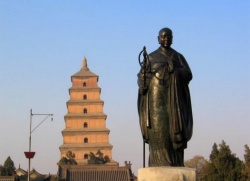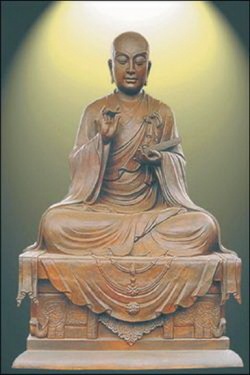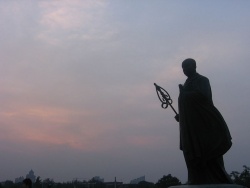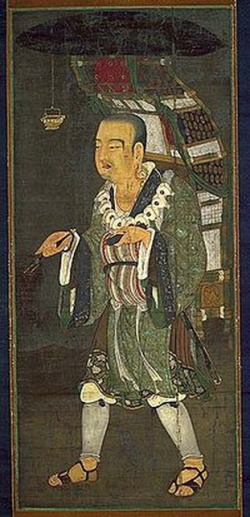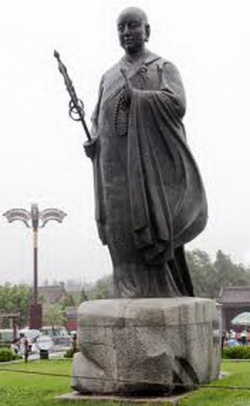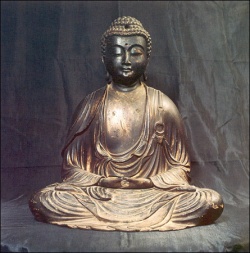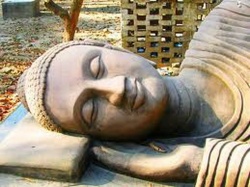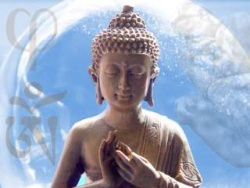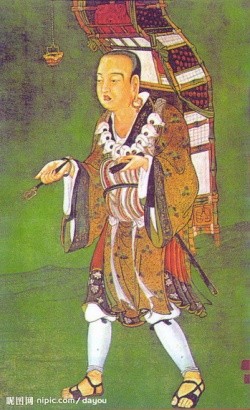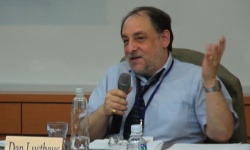Xuanzang (Hsüan-tsang)
by Dan Lusthaus
Xuanzang, who was born in 600 CE in Zhenliu (today called Kaifeng), China, had become one of the most renowned and influential men in Asian history by the time of his death in 664 at Jade Flower Palace Monastery near Changan (the capital). His fame stemmed from three related accomplishments:
Despite being expressly forbidden by the Emperor to journey to India, in 629 he risked his life to make a pilgrimage to the homeland of the Buddha, hoping to retrieve and study texts still unknown in China. The travelogue he composed (at the insistence of the Emperor, who embraced and supported Xuanzang once he triumphantly returned in 645), entitled Record of Western Lands (Xiyuji), continues to offer us an unparalleled account of the geography, life, and customs of seventh century Central Asia and India. Many of his descriptions of locales were so accurate that in the 19th and 20th centuries, Western Explorers such as Ariel Stein used his travelogue as a guidebook to rediscover sites lost for many centuries, and to identify those sites once found.
After his return to China, partly because of his unrivaled erudition, partly because of the eminent reputation he had earned in India and Central Asia, and partly because the Chinese Emperors offered him special patronage, even building special monasteries to house him and the Imperially selected translation committees assigned by the Emperor to assist him in translating texts from among the over 600 he brought back to China, Xuanzang became the most prominent Buddhist of his generation in East Asia. Students flocked to him from all over China, as well as Korea and Japan, while emissaries from India and Central Asian kingdoms came to pay their respects. In addition to introducing new Buddhist and Indian literature to the Chinese, he also influenced Chinese art and architecture with pieces and designs he brought back. A pagoda that was built to his specifications in Changan (today called Xian) to house the texts and artworks he had carted back to China still stands as a major landmark in that city.
He was one of the greatest and most prolific (and accurate) Chinese translators of Indian Buddhist texts. Some his translations, such as the Heart Sutra and Diamond Sutra, continue to play a major role in daily Buddhist forms of reverence until this day. The range of his translations is unrivalled, not only representing the teachings of the Yogacara school to which he adhered, but covering the full range of Buddhist literature, from visualization and dhāranī texts, to devotional tracts, to abhidharma, the complete prajñā-pāramitā corpus (this corpus alone filling three entire volumes of the Taishoo edition of the Chinese Buddhist canon), Āgama sutras, Mahayana sutras, important commentaries on sutras and śāstras, Buddhist logic texts (he was the only one to ever translate Buddhist logic texts into Chinese), and even a Hindu Vaiśeṣika text.
By Xuanzang's lifetime, Chinese Buddhism was experiencing a proliferation of competing Buddhist schools and doctrines, many holding views at fundamental odds with their rivals. Many of these schools based themselves on apocryphal texts pretending to be translations of Indian originals as well as authentic texts into which questionable translations had introduced a host of erroneous ideas that were nonetheless becoming increasingly popular in China and Korea. After returning to China from sixteen years in Central Asia and India, Xuanzang endeavored to bring the Chinese Buddhism of his day back into conformity with what he had learned in India. This he did by retranslating important texts, striving for more accurate renditions, as well as introducing new texts and materials previously unknown in China. Alongside his monumental translation work-74 texts in nineteen years, some quite sizable, such as the aforementioned Mahā-prajñāpāramitā sūtra which is several thousand pages long-he trained monks in the complexities of the Yogācāra system and Indian logic, and was the leading advocate for Buddhism at the Chinese Imperial Court until his death. His translations mark the last major infusion of Indian Buddhist ideas into East Asia.
Xuanzang's motives for going to India
By the early seventh century Chinese Buddhist literature had become a vast sea of translations and original Chinese works representing and supporting many opposing theories and positions, all of which were professedly "Buddhist." Chinese Buddhism in the sixth century could, with some justification, be seen as a battleground between competing versions of Yogācāra Buddhism, i.e., the teachings based on the writings of Asaṅga and Vasubandhu. Details of doctrine, both fine and fundamental, were in perpetual dispute.
While still quite young Xuanzang studied and mastered much of the available Buddhist literature. He was giving lectures to assemblies of monks by the age of thirteen. The Sui Dynasty (589-618) was collapsing, famine and war were spreading death and uncertainty throughout many parts of China, so numerous leading Buddhist scholars and their students converged on Changan, the capitol of the emerging Tang Dynasty, where they received support and could practice and teach with relative security. Xuanzang too went to Changan, and after studying with several prominent teachers, gained a reputation for great erudition and original thinking. He came to the conclusion that the many disputes and interpretational conflicts permeating Chinese Buddhism were the result of the unavailability of crucial texts in Chinese translation. In particular, he thought that a complete version of the Yogācārabhūmi-śāstra, an encyclopedic description of the stages of the Yogācāra path to Buddhahood written by Asaṅga, would resolve all the conflicts. In the sixth century an Indian missionary named Paramārtha (another major translator) had made a partial translation of it. Xuanzang resolved to procure the full text in India and introduce it to China.
Xuanzang in India
Despite the Emperor's refusal to grant Xuanzang permission to travel, he left nonetheless, encountering many hardships along the way as he crossed mountains and desert, faced starvation and murderous robbers, finally arriving nearly a year later in India. Once there he realized that the disparity between Indian and Chinese Buddhism involved much more than the missing chapters of one text. For over a century Indian Buddhists had become captivated by Dignāga's syllogistic logic, but even though some of Dignāga's epistemological treatises had been translated, Buddhist logic, which had become an integral part of all Indian forms of Buddhism, was still unknown in China. Xuanzang also discovered that the intellectual context in which Buddhists disputed and interpreted texts was much vaster and more varied than the Chinese materials had indicated: Buddhist positions were forged in earnest debate with a range of Buddhist and non-Buddhist doctrines unknown in China, and the terminology of these debates drew their significance and connotations from this rich context. While in China Yogācāra thought and Tathāgata-garbha thought were becoming inseparable, in India orthodox Yogācāra seemed to ignore if not outright reject Tathāgata-garbha thought. Many of the pivotal notions in Chinese Buddhism (e.g., Buddha-nature) and their cardinal texts (e.g., The Awakening of Faith) were completely unknown in India.
Xuanzang spent many years studying with India's most illustrious Buddhist teachers, visiting holy sites, and debating various advocates of Buddhist and non-Buddhist doctrines, defeating all of them and gaining a reputation as a fierce debater. After one series of debates with two Madhymakans (followers of Nāgārjuna's teachings), he composed in Sanskrit a three-thousand verse treatise on "The Non-difference of Madhyamaka and Yogācāra" which is no longer extant. After promising śīlabhadra, his mentor at Nālandā University (the central seat of Buddhist learning at that time), to introduce Dignāga's logic to China, he returned in 645 with over six hundred Sanskrit texts.
His translation project
Hoping to gain valuable tactical military information from Xuanzang, the Emperor installed him in a special monastery near the capitol, and assigned some of the leading scholars of the day to assist Xuanzang in his translation projects. Though refusing to provide the Emperor with information that might be useful militarily, he did write a travelogue describing the places he'd been, and especially the Buddhist sites he had visited. This work, Record of Western Lands, offers us today our most comprehensive view of the life, customs, manners, geography, and the condition of Buddhism in Central and South Asia in the seventh century.
The scope of materials he translated covers almost the whole range of Buddhist teachings: there are Yogācāra texts with their commentaries; Madhymaka texts with Yogācārin commentaries; devotional texts (Xuanzang was the first to associate the notion of "Pure Land"-a realm presided over by a Buddha into which one can be reborn-with Sukhāvatī, the realm of Buddha Amitābha; this particular "pure land" eventually became the most popular in East Asia); tantric and dhāranī (incantation) texts; logic manuals; Major sūtras (canonical accounts of the Buddha); Abhidharmic texts (especially the Vaibhāṣika abhidharma canon) as well as the Abhidharma-kośa-bhāṣya of Vasubandhu; and a Hindu Vaiśeṣika text. Conspicuously missing are Tathāgata-garbha texts. Although comprehensive, his selection of materials was not arbitrary. Rather than compose polemical tracts championing one sectarian viewpoint over another, he presented accurately translated authentic texts that themselves would, he hoped, set the record straight. He apparently found the teachings that followed the translations of Paramārtha, the sixth century Yogacarin translator, particularly problematic. Paramārtha's followers held Asaṅga's Mahāyānasamgraha śāstra (Ch. She lun) as central. Xuanzang not only retranslated the She lun. He also translated full commentaries on the She lun, including Vasubandhu's, in the hopes of indicating to the Chinese audience what the original text did and didn't say, as well as how it was understood and interpreted in India. Though the original Sanskrit is no longer extant, comparisons between Xuanzang's version with the Tibetan translations indicate that his renditions were much closer to the original than were Paramārtha's (Xuanzang's rendition is virtually identical to the Tibetan in most repects, while Paramārtha's text is filled with glosses and questionable digressions).
Word quickly spread throughout East Asia about Xuanzang: that he had been to India to study Buddhist teachings at their source; that he was uniquely patronized by the Chinese Emperor; that he was introducing through his translations new, authentic teachings previously unknown in East Asia. His Japanese students carried his teachings back to Japan, establishing the Hossou (lit: Dharma-characteristic) school which was to be the preeminent Buddhist school there until the advent of Japanese Tendai (Tiantai, T'ien-t'ai), which, through deliberate political machinations, usurped it a few centuries later. While his teachings spurred interest in Korea, they were eventually syncretized with Huaom (Huayen) and Son (Chan, Zen) teachings which have dominated Korean Buddhist thought for the last thousand years.
The Cheng weishi lun (Ch'eng wei-shih lun) and Kuiji
In 659 he produced his most unusual work. Intending to translate ten separate commentaries on Vasubandhu's Thirty Verses, at the dire insistence of his major disciple, Kuiji (K'uei-chi), he instead blended their interpretations and arguments together into a single text that, when read along with the commentaries Kiuji later wrote on it, became a catechism for Chinese and Japanese Yogācāra doctrine. After Xuanzang's death, Kuiji established the Weishi (Wei-shih) sect taking the Cheng weishi lun as his root text. Kuiji wrote several commentaries to it, most of which are extant, and his interpretations and expositions have been followed throughout East Asian history as the orthodox reading of the text. There are a number of reasons for being suspicious about Kuiji's claims, however:
While for Kuiji this text was the singularly most important treatise, there is no evidence that it held any special significance for Xuanzang, who may in fact have regretted amalgamating rather than faithfully translating the original commentaries. The last major text Xuanzang translated was the massive Mahā-prajñāpāramitā sūtra. Due to its size and his failing health he considered abridging his translation but was tortured by dreams warning him that omitting even a single word would be a grave error. This may very well reflect his residual remorse at having 'mistreated' the commentaries on the Thirty Verses that he didn't faithfully translate while composing the Cheng weishi lun, which he had only completed the year before.
Though Xuanzang's eminence was unassailable, his prestige did not automatically transfer to Kuiji, who had to fight several tenacious rivals, including Fazang (Fa-tsang), a foundational thinker for what was to become the Huayen sect. Historically, Fazang proved victorious over Kuiji, since the influence of Xuanzang's orthodox teachings declined rapidly during Kuiji's lifetime.
Even among the followers of Xuanzang, there was some dispute over who was his proper heir, and the key justification offered by Kuiji and his supporters for his claim to succeed Xuanzang was his unique access to the Cheng weishi lunbased on the presumption that Kuiji alone had been privy to Xuanzang's secret teachings on the text. The rival heir was a Korean monk named Wonch'uk, whose commentary on Cheng weishi lun Kuiji attacked with polemical and vitriolic vigor.
Kuiji's commentaries treat Cheng weishi lun as a catechism, refuting the erroneous theories attributed to some of the commentaries while promoting the correct interpretation, which, according to Kuiji was invariably the position of Dharmapāla, a sixth century Indian Yogācārin. While the Cheng weishi lun itself never explicitly attributes any position to any of the Sanskrit authors (in fact, they are never mentioned or named anywhere in the Cheng weishilun itself), Kuiji fastidiously makes such attributions, but, at least in the case of the one Sanskrit commentary still extant against which we can check his attributions, that of Sthiramati (an important fifth-sixth century Yogācārin), his attributions are fallacious.
An account Kuiji offers of a secret transmission of Dharmapāla's commentary to Xuanzang by a lay-follower of Dharmapāla's while Xuanzang was in India is internally inconsistent and contradicts other contemporary evidence suggesting such a transaction never took place. Kuiji likely invented the story to bolster his own claim to authority, since he would have inherited this 'secret' transmission from Dharmapāla through Xuanzang.
Thus, though the East Asian tradition has consistently relied on Kuiji's commentaries for interpreting the text, thereby assuming it presents and champions the view of Dharmapāla, this is probably an exaggeration if not an outright fabrication. Kuiji had much to gain-or so he thought-in garnering exclusive rights to the Cheng weishi lun, but he may have been overzealous, and a bit overly creative in exercising those rights.
Significant positions in Cheng weishi lun
Using Vasubandhu's Thirty Verses for its skeleton structure, the Cheng weishi lun is an encyclopedic account of orthodox Yogācāra doctrine and its disputes with other Yogācārins as well as non-Yogācārins. It includes detailed discussions of the eight consciousnesses, one hundred dharmas, three self-natures, Buddhist causal theories, and the five-step path to Buddhahood, as well as sundry other topics of concern to Indian and Chinese Buddhists in the seventh century. Since this text is not merely a translation (I would argue it is much less a translation than is usually assumed), whether or not Kuiji's interpretations are followed, it remains our only source for Xuanzang's own philosophical and doctrinal leanings (aside from Record of Western Lands, which is more inspirational than doctrinal or philosophic in tone, and Bashi guizhu song, 'Verses on the Structure of the Eight Consciousnesses,' a relatively concise verse text that covers some of the same topics as the Cheng weishilun, and, besides the Cheng weishilun and Record of Western Lands, is the only other Chinese text written by Xuanzang that is not a translation). Several of its major ideas contrast sharply with ideas that were commonly accepted by Chinese Buddhists at that time.
While the term Tathāgata-garbha (Ch: rulaizang) never appears in Cheng weishi lun (though Xuanzang repeatedly refers to the ālaya-vijñāna as zangshi 'repository consciousness'), refuting it along with its attendant ideological notions is one of Cheng weishi lun's obvious agendas (which is one reason that advocates of Tathāgata-garbha thinking, such as Fazang, attacked Xuanzang's teachings). Chinese Tathāgata-garbha rhetoric compared the "pure," "unconditioned" nature of Tathāgata-garbha with spatiality (Skt: ākāśa; Ch: Xukong), infinitely extended everywhere while neither impeding nor being impeded by anything. Cheng weishi lun argues that 'spatiality' is a mental construct produced by habitually visualizing some image of spatiality that one has heard about. All "unconditioned" dharmas are similarly linguistic fictions, including one of Tathāgata-garbha's most important synonyms, tathatā (Suchness). For many Chinese Buddhists Suchness evoked the idea of a metaphysical, subtending reality, clearly accessible only to the enlightened. Cheng weishi lun says: "The unconditioned dharmas are all nominal-fictions (Skt: prajñapti, Ch: jiaming) established on the basis of Suchness; and Suchness also is a nominal-fictitious term.... We are not the same as other schools (who claim) that apart from material-form, mind, etc., there exists a real, permanent dharma called by the name 'Suchness.' Instead, (we say) the unconditioned dharmas definitely are not real existents."
Cheng weishi lun contrasts three 'levels' of reality:
the utterly false and erroneous, which includes logical chimera, erroneous cognitions (e.g., hallucinations), etc.
the nominally-fictitious which are linguistic-conceptual creations mistaken for real existent things. For Cheng weishi lun this is a double-edged sword, since while such fictions may lead people to believe in and attach to things that are not the case, the fictions of Buddhist teachings (e.g., the concept of Suchness) can help liberate people from the fictitious altogether.
Real existents, which Cheng weishi lun defines as momentary, produced by causes and conditions, and producing an observable effect. Thus something permanent and non-observable, such as God or Suchness, is not real, while a moment of conscious sense-perception is real. All three are further defined as 'conventionally true' (saṃvṛti-sat). What is 'ultimately true' (paramārtha-sat) is the flux of mutually dependent, momentary conditions (paratantra).
Tathāgata-garbha thought, especially as promulgated by the translator Paramārtha, reified the Mind as the true, subtending, eternal cause of everything, recognition of which constitutes enlightenment. Cheng weishi lun sharply distinguishes its own use of the terms "consciousness only" and "mind only" from that idea. "To oppose false attachment to the view that external to mind and mental-concomitants (citta caitta) there are real existent perceptual-objects, we say that only consciousness exists. If you attach to 'only consciousness' as something truly existent, that is no different than being attached to external sense-objects, that is, just another dharma-attachment." External objects are denied in order to focus epistemologically on the fact that whatever is known directly happens only within consciousness; that we are trapped in this narcissistic mirror is the problem, not the solution. Breaking this epistemological closure by turning the consciousnesses into 'direct cognitions' (jñāna) is Cheng weishi lun's goal.
Finally, the idea the Chinese found most controversial derived from Cheng weishi lun's use of the Yogācāra seed metaphor. Claiming that each consciousness stream has 'seeds' that have inhered in it beginninglessly as well as seeds that it acquires through novel experiences (i.e., nature vs. nurture), Cheng weishi lun spells out the classic Yogācāra doctrine of five gotras or soteriological 'families.' The inherent seeds determine one's soteric possibilities. Three of the types represent the three traditional Buddhist images of an enlightened being: Arhat (one enlightened by studying Buddhism), Pratyekabuddha (one enlightened unassisted by discovering the causal principles at work in the world), and Bodhisattva (one who is enlightened through the Mahāyāna path). Each of these gotras has some, but not all of the pure seeds leading to enlightenment, and thus their degree of enlightenment is determined accordingly. Arhats have the least, Bodhisattvas more, with Pratyekabuddhas in between. Those in possession of the full complement of pure seeds can become Buddhas. The controversial aspect of this model concerns those who utterly lack any pure seeds whatsoever and are thereby incapable of enlightenment. This violated the Chinese Buddhist notion, based on the Nirvana Sutra and other scriptures popular in China, that Buddha-nature is universal, so that all beings are capable of enlightenment. No doctrine in Cheng weishi lun was more vehemently attacked by opponents than this one.
Xuanzang's legacy
Of all the works translated by Xuanzang, the one that has remained the most popular, and which has been chanted daily throughout East Asia for over a thousand years, is the Heart Sutra. Famous for its line, "form is emptiness, emptiness is form," it was also what Xuanzang himself chanted at the moment of his death.
His journey to India has continued to excite the East Asian imagination. It was the inspiration for Wu Chengen's Journey to the West, one of China's most famous and popular novels (pub. 1592). In it Xuanzang is accompanied on his journey by a brash, courageous, mischievous, impatient, arrogant, magical monkey (symbolizing the human mind). The novel has been the subject of countless dramatic treatments over the centuries, including a long-running Chinese television serial and a popular Japanese children's t.v. show in which Xuanzang was played by a woman.
Major Ideas
Buddhist method requires logic.
Metaphysical notions such as Buddha-nature and tathāgata-garbha (Buddha's embryo within all beings) distort basic Buddhist teachings.
So-called Buddhist absolutes, e.g., Suchness and Unconditioned Dharmas, are not real but merely linguistic-conceptual creations.
Only what is momentary and produces an observable effect is 'real' (dravya); the 'real' is contrasted with the 'erroneous' and the 'nominal' (prajñapti).
A person's spiritual possibilities are shaped by a combination of inherent and acquired karmic "seeds" that must be brought to fruition.
There is no contradiction between the teachings of Madhyamaka and Yogācāra.
Bibliography
Tat, Wei. Ch'eng Wei Shih Lun. The Doctrine of Mere-Consciousness. Hong Kong: The Ch'eng Wei-shih Lun Publication Committee, 1973. The late Tat, a Hong Kong Businessman, produced this volume out of devotion to the text. Though the Chinese is on facing pages, the English translation is directly from the French version of Vall'ee Poussin, minus Vall'ee Poussin's extensive notes. For those who cannot read French, this is the only other complete Western language version.
Vall'ee Poussin, Louis de la. Vijñaptimātratāsiddhi: La Siddhi de Hiuan-tsang. Paris: Paul Geuthner, 1929, 2 vols. The standard Western translation used by scholars. Vall'ee Poussin believed Yogācāra was a form of idealism, and translated and paraphrased accordingly. His rendition is very loose in places, relying heavily on Kuiji's commentary.
Beal, Samuel. Si-Yu-Ki: Buddhist Records of the Western World. NY: Paragon Book Reprint, 1968 A readible, useful translation of Xuanzang's Record of Western Lands. A Classic.
Hui Li (completed by Yan Cong). Ta-t'ang ta-tz'u-en-ssu san-tsang fa-shih chuan (Biography of Hsan-tsang) (T.50.2053);
Abridged Eng. tr. by Li Yongxi, The Life of Hsuan tsang: The Tripitaka-Master of the Great Tzu En Monastery, Peking: Chinese Buddhist Association, 1959. This biography of Xuanzang was written by his contemporary, covering his childhood, his studies, trip to India, and events until his death. The last four fascicles were completed by Yan Cong (and others) after Hui Li's death. A few sections are omitted in this translation, but it is a fine work. Be warned that Li's attempts at reconstructing Sanskrit names are not always accurate;
First half also translated in Beal, The Life of Hiuen-Tsiang. Delhi: Munshiram Manoharlal, 1973 (rpt. of 1911 Kegan Paul ed.)
Lusthaus, Dan. Buddhist Phenomenology: A Philosophical Investigation of Yogācāra Buddhism and the Ch'eng wei-shih lun. London: Curzon, 2000
Waley, Arthur. The Real Tripitaka . NY: Macmillan, 1952. A very enjoyable recounting of the life of Xuanzang, containing much information not available elsewhere in English. Waley did this as a companion to his partial translation of Journey to the West, which he entitled Monkey: Folk Novel of China. NY: Evergreen, 1958. Monkey makes delightful, exciting reading.
Wriggins, Sally Hovey. Xuanzang: A Buddhist Pilgrim on the Silk Road. Oxford: Westview Press, 1996. A very readable overview of Xuanzang's travels.
Yu, Anthony. The Journey to the West. Chicago: University of Chicago Press, 1977-83, 4 vols. Yu provides an unabridged translation of the novel. While not as exciting to read as Waley's version, it is more literally faithful to the original, providing a much broader view of Chinese views and attitudes.
